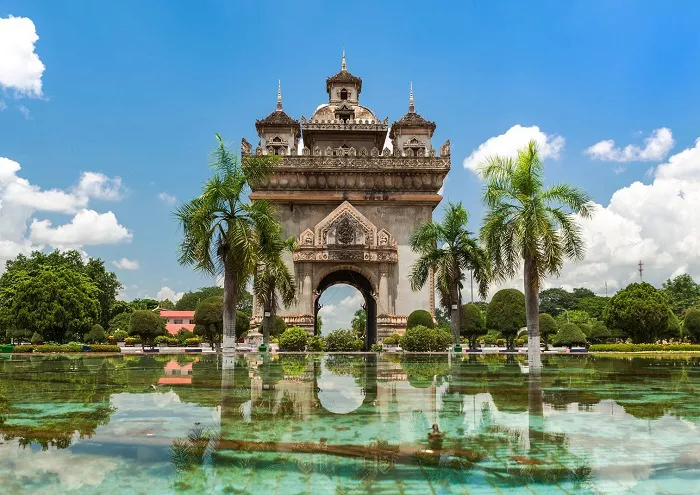Vientiane Province has experienced a notable increase in tourism, with 902,057 visitors recorded in the first quarter of 2025. This figure includes 416,232 domestic tourists and 485,825 international travelers. The region’s tourism sector is flourishing, driven by popular destinations such as the 1st Nam Ngum Reservoir in Keo Oudom District, Vang Vieng, and Feuang District, collectively contributing to an estimated 754 billion kip in tourism revenue.
Key Attractions and Activities Boosting Visitor Numbers
Among the most sought-after activities in Vientiane Province are boat rides along the scenic Xong River and adventurous experiences like sling riding, bungee jumping, and paramotoring in Vang Vieng. Other popular spots include the Nam Leek House in Feuang District and the 1st Nam Ngum Reservoir, offering visitors a mix of cultural, recreational, and natural experiences. This broad spectrum of activities has enhanced the province’s appeal to a wide range of tourists, from thrill-seekers to those in search of cultural enrichment or relaxation.
Collaborative Efforts in Tourism Development
According to Mr. Sengkeo Sounthavongsa, Deputy Director of the Vientiane Provincial Department of Information, Culture, and Tourism, the provincial government is working closely with both public and private sectors to promote tourism. Speaking on April 4, 2025, he emphasized that the province’s success in diversifying its tourism offerings is key to attracting a larger number of visitors. The partnership between government bodies and the private sector has been instrumental in overcoming challenges and improving the overall tourist experience.
This approach reflects a broader trend in Laos, where public-private collaborations are increasingly recognized as essential for regional tourism growth. By offering a range of experiences—ranging from eco-tourism to adventure and cultural exploration—Vientiane Province is well-positioned to cater to a variety of traveler preferences.
Growing Tourism Infrastructure
Vientiane Province is home to over 1,000 licensed tourism businesses, including hotels, resorts, travel agencies, and entertainment venues. The region offers a variety of accommodation options, with 61 hotels providing 2,129 rooms, 37 resorts with 1,206 rooms, and 327 guesthouses totaling 4,838 rooms. There are also 369 restaurants and entertainment venues, 39 travel agencies, and 71 tourism service units. The province boasts 238 tourist attractions, 62 of which are fully operational.
This robust tourism infrastructure underscores the province’s ongoing commitment to delivering a top-tier travel experience for both domestic and international visitors. The continued development of high-quality accommodations and services further solidifies Vientiane Province’s standing as a leading destination in Laos.
Recognition for Quality Tourism Standards
Vientiane Province has earned recognition for its high tourism standards, receiving six awards at the 2024 ASEAN Tourism Standards Awards. Among these awards are accolades for one 5-star hotel, two 4-star hotels, and 14 establishments certified under Lao SEP standards. These honors highlight the province’s dedication to maintaining excellence in its tourism services and infrastructure, ensuring that visitors enjoy a world-class experience.
This recognition signals Vientiane Province’s growing reputation on the global tourism stage, positioning it as a prime destination for international travelers seeking high-quality, sustainable travel options.
Ambitious Tourism Goals for 2025
Looking to the future, Vientiane Province is targeting 2 million visitors in 2025, with expected tourism revenue surpassing 1,820 billion kip. These ambitious goals reflect the province’s ongoing popularity and the strategic development of both domestic and international tourism sectors.
This aligns with Laos’ broader efforts to strengthen its tourism industry as a major economic contributor. As the country continues to invest in infrastructure and tourism services, Vientiane Province is poised to play a significant role in the national economy, particularly in job creation and regional development.
Cultural Events Driving Tourism Growth
Vientiane Province’s tourism growth is also fueled by its vibrant cultural scene. In 2024, the province celebrated Visit Laos Year with a series of festivals, including the Sam Muen Toup Feuang Festival in Feuang District, the Kalampi Festival, the Sweet Orange Festival, and the International Music and Fireworks Festivals. Vang Vieng District hosted the Boat Racing Festival, while various ethnic groups celebrated traditional events like the Kin Chiang Festival of the Hmong and the Khmu New Year Festival.
These cultural events not only showcase the region’s rich heritage but also contribute to tourism by attracting visitors eager to experience Laos’ diverse cultural traditions. The growing popularity of cultural tourism further strengthens Vientiane Province’s position as a major destination for travelers interested in authentic local experiences.
Continued Growth in 2024 and Beyond
In 2024, Vientiane Province welcomed 1.9 million visitors, including 865,533 women, generating over 1,372 billion kip in revenue. The province’s ability to attract both domestic and international tourists highlights the increasing variety of its tourism offerings, which include eco-tourism, cultural heritage, adventure tourism, and luxury accommodations.
As Laos’ tourism industry continues to expand, Vientiane Province stands out as a key player in attracting international visitors. Its combination of natural beauty, cultural festivals, and growing infrastructure positions it as a top destination in Southeast Asia.
Conclusion: A Bright Future for Vientiane Province Tourism
Vientiane Province’s innovative tourism development strategies, coupled with its commitment to sustainability and high-quality services, are paving the way for continued success in the coming years. With ambitious growth targets for 2025 and beyond, the province is poised to become a leading player in the regional tourism market, attracting visitors from across Asia and beyond.

